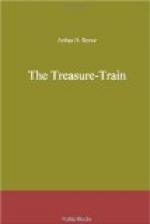It was all very interesting and we talked with men whom it was a pleasure to see handling great problems so capably. But none could shed any light on the problem which it was Kennedy’s to solve. And yet I felt sure, as I watched Craig, that unsatisfactory as it appeared to Marlowe and to myself, he was slowly forming some kind of theory, or at least plan of action, in his head.
“You’ll find me either here or at the hotel—I imagine,” returned Marlowe to Kennedy’s inquiry as we parted from him. “I’ve instructed all the men to keep their eyes open. I hope some of us have something to report soon.”
Whether or not the remark was intended as a hint to Kennedy, it was unnecessary. He was working as fast and as surely as he could, going over in hours what others had failed to fathom in weeks.
Late in the afternoon we got back to the laboratory and Craig began immediately by taking from the little electric incubator the two crooked tubes he had left there. Breaking off the ends with tweezers, he began examining on slides the two drops that exuded, using his most powerful microscope. I was forced to curb my impatience as he proceeded carefully, but I knew that Craig was making sure of his ground at each step.
“I suppose you’re bursting with curiosity,” he remarked at last, looking up from his examination of one of the slides. “Well, here is a drop that shows what was in the grooves of that bullet. Just take a look.”
I applied my eye to the microscope. All I could see was some dots and rods, sometimes something that looked like chains of dots and rods, the rods straight with square ends, sometimes isolated, but more usually joined end to end in long strings.
“What is it?” I asked, not much enlightened by what he had permitted me to see. “Anaerobic bacilli and spores,” he replied, excitedly. “The things that produce the well-known ‘gas gangrene’ of the trenches, the gas phlegmon bacilli—all sorts, the bacillus aerogenes capsulatus, bacillus proteus, pyogenic cocci, and others, actively gas-forming microbes that can’t live in air. The method I took to develop and discover them was that of Col. Sir Almroth Wright of the British army medical corps.”
“And that is what was on the bullet?” I queried.
“The spores or seeds,” he replied. “In the tubes, by excluding the air, I have developed the bacilli. Why, Walter,” he went on, seriously, “those are among the microbes most dreaded in the infection of wounds. The spores live in the earth, it has been discovered, especially in cultivated soil, and they are extraordinarily long-lived, lying dormant for years, waiting for a chance to develop. These rods you saw are only from five to fifteen thousandths of a millimeter long and not more than one-thousandth of a millimeter broad.




